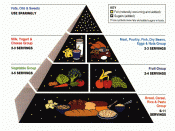The USDA (U.S. Department of Agriculture) food pyramid is a graphic organizer that was released in 1992 to convey the need to Americans to eat well. First conceived in the 60s, the idea of a food pyramid was the result of significant rises in Americans suffering heart disease. Three main ideas were the basis for the original food pyramid: proportion, moderation and variety. However, since 1992 the field of nutrition has matured and the facts illustrated in the USDA food pyramid are not necessarily still to the best of our knowledge. But one would do well to wonder if they ever were. For one thing, the creators of the USDA food pyramid work for a branch of the government that has the interests of American agribusiness at heart, not nutrition. And while many experts helped to build the food pyramid, so did many food industries. Lobbying from the wings were the American Meat Institute, Soft Drink Association, National Dairy Council and many others who helped to shape the USDA food pyramid into what it is.
It's no surprise they're all so interested; the Dietary Guidelines for Americans are also guidelines for how billions of dollars every year will be spent.
While the USDA food pyramid has become dated, other food pyramids and diets have sprung up. One in particular, the nonprofit organization Oldways, has created four different food pyramids based on cultural diets of the past, diets that have been proven to promote a healthy lifestyle with low risk of disease. The Vegetarian, the Mediterranean, the Asian and the Latin American food pyramids are all based on cultures of the past that are known to have had good health and few diseases, except the Vegetarian which is simply a guide to eat well without meat, poultry or fish.


